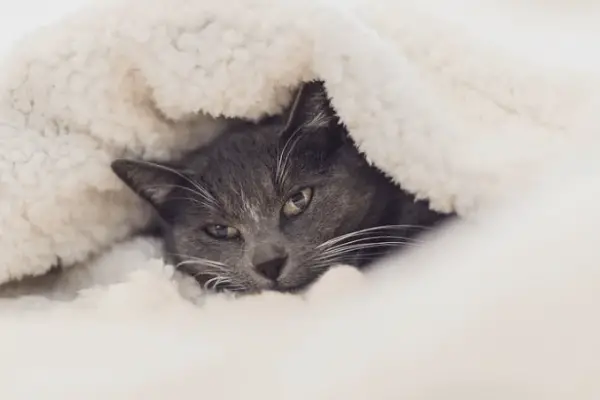How Do Indoor Cats Get Fleas: 10 Common Ways & Prevention

Cat owners always ask how do indoor cats get fleas, in this post, you will learn all the common and possible ways indoor cats can get fleas.
Fleas are one of the biggest problems for indoor cats. Fleas can be both an annoyance and a health issue to your pet.
They may cause itching, scratching, hair loss, and red bites on themselves or their human caretakers.
If you find fleas on your cat, it can be a big cause for concern. Fleas are tricky and not only irritating to your animal, but they also carry diseases.
The question is: how did the fleas get on your pet in the first place?
The answer is easy: if you have an indoor cat and don’t remove the flea eggs from their living area, they will hatch and breed, and soon enough they will hop onto your cat!
How Do Indoor Cats Get Fleas
Cats often get fleas from other animals or by spending time outdoors. Fleas feed on the blood of their hosts and will live off of your cat until they die.
This is problematic because fleas larvae frequently cause anemia in cats, which can lead to death.
Indoor cats are not immune to fleas. Fleas live in the carpet, on furniture, and in the yard. The eggs can also be present in any of these areas.
So if an infested animal like a raccoon or squirrel enters your home, that’s enough exposure for indoor cats to get fleas, and they can actually be more susceptible to it than outdoor cats.
Fortunately, there is a lot you can do to stop the problem before it starts.
What are fleas
Fleas are tiny insects that dwell on warm-blooded mammals’ skin. They feed on blood by biting and biting.
Because they feed on the blood of their hosts, fleas are generally called blood-sucking parasites.
Fleas flourish when they can deposit their eggs on animals that are nutritionally deficient (warm, dry, confined, and without access to shade or shelter), or when they live near to their host.
Fleas are more likely to bite your dog than cats, as a result of this, there are many ways to keep fleas away from dogs. But we will cover the cat aspect in this post.
Because most breeds of cat’s fur fall off in the winter, fleas find it simpler and more appealing to feed on it.
Can indoor cats get fleas
Indoor cats, even if they never go outside, can get fleas right inside your home.
Fleas are very tough and cunning little animals, so it’s very simple for cats to catch fleas even when they aren’t outside.
Consider yourself lucky if you believed your indoor cats never got fleas or were protected from getting fleas.
Common ways indoor cats can get fleas
Here’s what you need to know about keeping your home safe from pesky fleas and how indoor cats get fleas:
Indoor cats can get fleas from visiting the veterinary office
Flea infestations are one of the most common reasons pet owners take their animals to the veterinarian.
Fleas are quite excellent at concealing, no matter how clean your veterinarian’s workplace is.
Taking your indoor cat to the vet for a routine check-up or immunization might expose her to fleas, flea eggs, and flea larvae, which she may bring home with her.
Indoor cats get fleas from their owners
Fleas are always on the lookout when you’re out and about in the world.
Fleas are always delighted to jump on your socks, grab onto your jeans, and otherwise have a good time with your belongings.
You bring the fleas home, and now you have a full-fledged flea infestation, with your cat at the center.
The bad news is that you can’t do much to avoid picking up fleas during flea season, but you can do a lot to make sure your cat’s skin doesn’t invite them in.
Every cat, including indoor cats, should be on flea and tick preventive medicine on a monthly basis.
You’ll never be able to make your house a flea-proof fortress, but you may assist your cat in surviving the onslaught.
Indoor cats can get fleas from wild animals around their territory
Fleas are a frequent nuisance on animals such as raccoons, rabbits, and opossums that dwell near your home.
These flea-infested animals can spread flea eggs throughout your yard or deck as they wander about.
Hitchhiker fleas are the result of these eggs hatching into adults that can hop on you and hitch a ride inside your home.
Indoor cats get fleas by just sitting at open windows or doors
Do you allow your cat to sit at open doors or windows? Is it common for your cat to sit at the window? Isn’t it possible to put it near the screen door?
Perhaps on the porch? Fleas are ever ready and among the most powerful jumpers in the animal kingdom.
Your cat may be enjoying some much-needed fresh air, but the cat is also exposing itself to the ever-present fearless fleas.
Keeping your cat’s flea and tick prevention medicine up to date, as well as working with an exterminator to guarantee your yard is flea-free, are your best bets for keeping fleas at bay.
Indoor cats can get fleas from sleeping on old furniture outside your house
Do you know that most indoor cats get fleas from sleeping on old or new furniture you keep outside your house!
You can accidentally introduce fleas into your house if you acquire furniture or carpets from someone whose pet has them.
If you move into a new residence, fleas from prior pets may already be there.
To avoid an unintentional flea transmission, clean everything completely.
Indoor cats can get fleas from other household pets
The most evident is this. If you have more than one pet, it’s easy to figure out whose bringing the fleas to your indoor cat.
Even if your indoor cat does not travel outside, he or she will undoubtedly get an infection from his canine companion.
This is why you should take flea and tick prevention measures for all of your pets, not just those that go outside.
Even a flea and tick product-treated dog can carry live insects and eggs into the house, especially if the product does not repel fleas and ticks, or if a large quantity of fleas and ticks outdoors overwhelms the product on the dog.
Indoor cats can get fleas after relocating into a new home
Fleas that have been latent for months might be waiting for your cat to come if you’re relocating.
Also keep in mind that in shared buildings, the hall carpets or your neighbor’s flat might be a flea breeding ground. This is also a way indoor cats get parasites.
To keep your cat safe, treat the area as if it were contaminated and try to get rid of any fleas or ticks with at-home remedies.
You may also hire a professional cleaning service or exterminator to assist you.
Fleas and ticks can be found on secondhand carpets, furniture, bedding, and luggage purchased from charity stores or infested houses, so thoroughly clean these items before bringing them into your home.
Indoor cats get fleas from chasing a flea infested mouse
Chasing an infected mouse is one of the most common ways indoor cats become infected with fleas.
Mice are rodents that, as a result of their environment and food, carry a range of fleas and diseases.
An indoor cat may easily get fleas by pursuing an infested mouse or other ill animals.
Mice frequently enter our home, and we’ve witnessed indoor cats chasing mice on a daily basis.
An indoor cat can get fleas by crossing the path or nest of a flea-infested mouse.
Indoor cats get fleas from unkept gardens
Flea eggs may infect your cat if your cat always walks through your home’s flowers or gardens.
Parasites are common in flowers and grasses, and an indoor cat will come into contact with them if it walks through them.
An indoor cat may parasitize by rubbing its body against the flowers or grasses on your property.
Flea larvae are located under leaves in the garden, and if they come into contact with a dog, they are transferred to the cat’s skin, where they can continue to grow.
Cats like playing in the yard, making it easier for them to get fleas; however, do not let your cat out when the leaves are moist, this is also a way indoor cats get worms.
Indoor cats get fleas from unkept human footwear
By roaming around the area where you store your shoes, indoor cats might get up parasites like fleas.
As you move from outside to inside, you can’t be sure your shoes aren’t carrying fleas eggs under them.
Parasites may be found nearly anywhere, including on human pathways, and they can stick to your shoes’ soles.
Even if your cat never leaves the house, family members are likely to come and go on a daily basis.
Because flea eggs may lay dormant for months, they’re easy to discover on clothing and shoes.
You can’t completely avoid them when you’re outside, but you can decrease the chance of contamination by taking off or cleaning your shoes before going outside or entering your home.
How to control fleas to avoid infestation
Here are some of the common proven ways to control fleas from infesting your cat or your home:
Keep your compound clean
Fleas thrive on stacked woodpiles of leaves and heaps of pebbles. The more clutter there is, the more places fleas may hide.
Make sure you properly clean your compound and keep anything that will attract fleas away from your home.
Vacuum your house regularly
To suck up any eggs before they hatch, clean the carpets, cushioned furniture, and cracks and crevices in the floor.
This method will also get rid of living fleas. When you’re done, remember to toss away the vacuum bag or wash out the canister with warm, soapy water.
Use natural flea control methods
Cedar Chips have a strong odor that repels fleas and ticks. Sprinkle them beneath your porch and patio furniture in shaded locations. Even if you walk over them, the powder will keep fleas away.
Wash as often as you possible
At least once a week, wash your clothes. Remove any bedding, sofa coverings, or other materials that your pet has gotten into and toss them in the washing machine right away. So that no bugs survive the wash cycle, use hot water.
Leave your footwear outside when you return home
If you have to walk through the grass to get to your front door, consider leaving your shoes and hitchhiking companions there as well.
This will not only help to decrease the possibilities of bringing fleas into your house on your shoes, but it will also help to keep your home’s floors and carpet cleaner and more appealing in general.
Spray your home once in a while
Remove any pets and family members from the house, then apply a flea spray to coat the carpets and other surfaces.
Methoprene or pyriproxyfen is a chemical found in the most effective sprays. Try a natural citrus spray if you’re concerned about chemicals in the house.
Pets, children, and others should be kept away until all surfaces have dried.
Groom your cat at least once per week
Grooming your dog or cat on a regular basis keeps them clean and allows you to check for fleas or ticks. It’s also a fantastic opportunity for you and your pet to bond.
How to handle fleas infestation
The only method to get rid of fleas is to get rid of them from your cat and your environment.
Despite the numerous commercial flea-killing treatments available, this is more difficult than it appears.
Vacuum and clean your house completely. Flea shampoo should be used on all fabrics and carpets.
Hiring a professional flea exterminator is a good idea.
Using a flea comb, remove fleas and their excrement from your cat’s fur.
Flea-killing medicines, either local or oral, can be used to rid him of the infestation.
Read all labels carefully since certain items that are acceptable for dogs are harmful to cats.
How to treat fleas in indoor cats
Traditional dusts, shampoos, and sprays are less safe, less convenient, and less effective than spot-on treatments.
You may get them from your veterinarian or get them online. Inquire with your veterinarian about where to apply the product, how much to apply, and how often to use it on your cat.
If you’re not obtaining the therapy from your veterinarian, check sure the product is safe for cats by reading the label.
The following are some examples of common active compounds and brands:
- Fluralaner
- Fipronil
- Selamectin
- Imidacloprid
Medicines that your cat may need:
Adult fleas on your cat are killed in 30 minutes with the tablet nitenpyram (Capstar).
However, it has no long-term consequences. Comfortis (Spinosad) is a fast-acting chewable that kills fleas before they lay eggs.
It offers a month’s worth of flea prevention to help prevent new fleas from developing.
Health challenges associated with fleas infestation in indoor cats
The very worst part about a flea infestation is that no matter how frequently your cat grooms, it can’t get away from these bugs.
Anyone who has ever dealt with a flea infestation understands how quickly the problem may spread to other pets in the house.
Fleas may wreak havoc on your cat’s happy-go-lucky existence, producing issues such as:
- Bartonella species infections
- Anemia
- Mycoplasma species infections
- Tapeworms
- Flea allergy dermatitis
What should I do if my cat gets fleas?
If your cat has fleas, you should act quickly. For treatment alternatives, speak with your veterinarian.
Eliminate as many fleas as possible with a flea comb, then vacuum regularly to remove fleas and their eggs from your carpets and floors.
Take the vacuum canister or dust bag outside as soon as possible.
Wrapping up
Fleas aren’t just a problem for outdoor cats. Surprisingly, indoor-only cats can also have fleas.
Even if you’ve never had a problem before. The flea eggs can lay dormant in the carpet and furniture for months on end.
In addition, an indoor cat may be exposed to fleas by going outside with their owners, visiting a friend’s house with an outdoor cat, or being bitten by a wild animal.
These are the major ways that your pet might be exposed to fleas without you realizing it.
Fleas can be among many reasons that cause trauma in cats and depression in cats, therefore, If you suspect your pet has fleas, it’s time to take action!



![Cat Lethargic Not Eating or Drinking [Reasons] Cat Lethargic Not Eating or Drinking](https://petcreeks.com/wp-content/uploads/2023/02/Cat-Lethargic-Not-Eating-or-Drinking-768x555.jpg)


